Dongsheng Jiang
Boosting Open-Domain Continual Learning via Leveraging Intra-domain Category-aware Prototype
Aug 19, 2024Abstract:Despite recent progress in enhancing the efficacy of Open-Domain Continual Learning (ODCL) in Vision-Language Models (VLM), failing to (1) correctly identify the Task-ID of a test image and (2) use only the category set corresponding to the Task-ID, while preserving the knowledge related to each domain, cannot address the two primary challenges of ODCL: forgetting old knowledge and maintaining zero-shot capabilities, as well as the confusions caused by category-relatedness between domains. In this paper, we propose a simple yet effective solution: leveraging intra-domain category-aware prototypes for ODCL in CLIP (DPeCLIP), where the prototype is the key to bridging the above two processes. Concretely, we propose a training-free Task-ID discriminator method, by utilizing prototypes as classifiers for identifying Task-IDs. Furthermore, to maintain the knowledge corresponding to each domain, we incorporate intra-domain category-aware prototypes as domain prior prompts into the training process. Extensive experiments conducted on 11 different datasets demonstrate the effectiveness of our approach, achieving 2.37% and 1.14% average improvement in class-incremental and task-incremental settings, respectively.
Improving Image Restoration through Removing Degradations in Textual Representations
Dec 28, 2023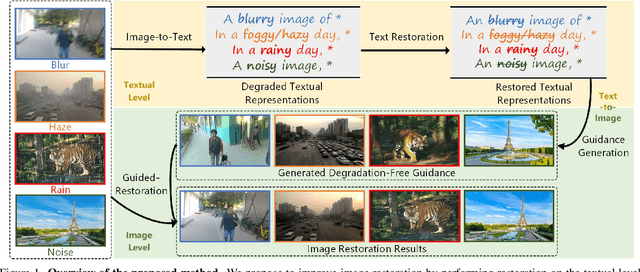
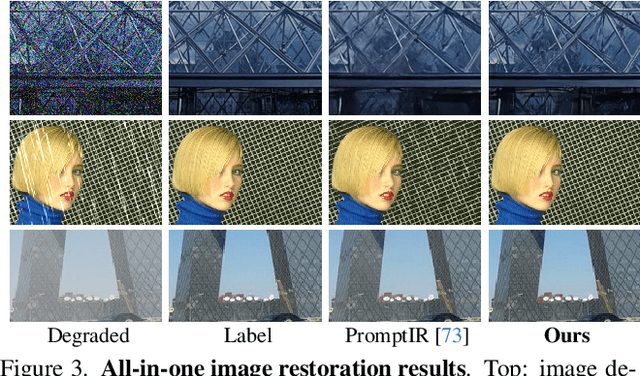

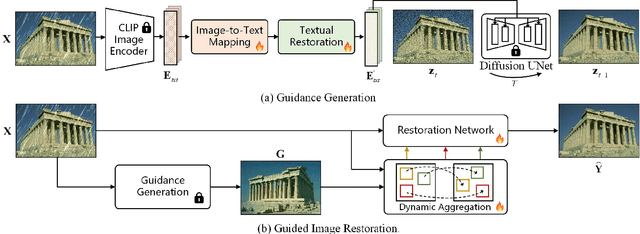
Abstract:In this paper, we introduce a new perspective for improving image restoration by removing degradation in the textual representations of a given degraded image. Intuitively, restoration is much easier on text modality than image one. For example, it can be easily conducted by removing degradation-related words while keeping the content-aware words. Hence, we combine the advantages of images in detail description and ones of text in degradation removal to perform restoration. To address the cross-modal assistance, we propose to map the degraded images into textual representations for removing the degradations, and then convert the restored textual representations into a guidance image for assisting image restoration. In particular, We ingeniously embed an image-to-text mapper and text restoration module into CLIP-equipped text-to-image models to generate the guidance. Then, we adopt a simple coarse-to-fine approach to dynamically inject multi-scale information from guidance to image restoration networks. Extensive experiments are conducted on various image restoration tasks, including deblurring, dehazing, deraining, and denoising, and all-in-one image restoration. The results showcase that our method outperforms state-of-the-art ones across all these tasks. The codes and models are available at \url{https://github.com/mrluin/TextualDegRemoval}.
AiluRus: A Scalable ViT Framework for Dense Prediction
Nov 02, 2023Abstract:Vision transformers (ViTs) have emerged as a prevalent architecture for vision tasks owing to their impressive performance. However, when it comes to handling long token sequences, especially in dense prediction tasks that require high-resolution input, the complexity of ViTs increases significantly. Notably, dense prediction tasks, such as semantic segmentation or object detection, emphasize more on the contours or shapes of objects, while the texture inside objects is less informative. Motivated by this observation, we propose to apply adaptive resolution for different regions in the image according to their importance. Specifically, at the intermediate layer of the ViT, we utilize a spatial-aware density-based clustering algorithm to select representative tokens from the token sequence. Once the representative tokens are determined, we proceed to merge other tokens into their closest representative token. Consequently, semantic similar tokens are merged together to form low-resolution regions, while semantic irrelevant tokens are preserved independently as high-resolution regions. This strategy effectively reduces the number of tokens, allowing subsequent layers to handle a reduced token sequence and achieve acceleration. We evaluate our proposed method on three different datasets and observe promising performance. For example, the "Segmenter ViT-L" model can be accelerated by 48% FPS without fine-tuning, while maintaining the performance. Additionally, our method can be applied to accelerate fine-tuning as well. Experimental results demonstrate that we can save 52% training time while accelerating 2.46 times FPS with only a 0.09% performance drop. The code is available at https://github.com/caddyless/ailurus/tree/main.
From CLIP to DINO: Visual Encoders Shout in Multi-modal Large Language Models
Oct 18, 2023Abstract:Multi-modal Large Language Models (MLLMs) have made significant strides in expanding the capabilities of Large Language Models (LLMs) through the incorporation of visual perception interfaces. Despite the emergence of exciting applications and the availability of diverse instruction tuning data, existing approaches often rely on CLIP or its variants as the visual branch, and merely extract features from the deep layers. However, these methods lack a comprehensive analysis of the visual encoders in MLLMs. In this paper, we conduct an extensive investigation into the effectiveness of different vision encoders within MLLMs. Our findings reveal that the shallow layer features of CLIP offer particular advantages for fine-grained tasks such as grounding and region understanding. Surprisingly, the vision-only model DINO, which is not pretrained with text-image alignment, demonstrates promising performance as a visual branch within MLLMs. By simply equipping it with an MLP layer for alignment, DINO surpasses CLIP in fine-grained related perception tasks. Building upon these observations, we propose a simple yet effective feature merging strategy, named COMM, that integrates CLIP and DINO with Multi-level features Merging, to enhance the visual capabilities of MLLMs. We evaluate COMM through comprehensive experiments on a wide range of benchmarks, including image captioning, visual question answering, visual grounding, and object hallucination. Experimental results demonstrate the superior performance of COMM compared to existing methods, showcasing its enhanced visual capabilities within MLLMs. Code will be made available at https://github.com/YuchenLiu98/COMM.
ControlVideo: Training-free Controllable Text-to-Video Generation
May 22, 2023Abstract:Text-driven diffusion models have unlocked unprecedented abilities in image generation, whereas their video counterpart still lags behind due to the excessive training cost of temporal modeling. Besides the training burden, the generated videos also suffer from appearance inconsistency and structural flickers, especially in long video synthesis. To address these challenges, we design a \emph{training-free} framework called \textbf{ControlVideo} to enable natural and efficient text-to-video generation. ControlVideo, adapted from ControlNet, leverages coarsely structural consistency from input motion sequences, and introduces three modules to improve video generation. Firstly, to ensure appearance coherence between frames, ControlVideo adds fully cross-frame interaction in self-attention modules. Secondly, to mitigate the flicker effect, it introduces an interleaved-frame smoother that employs frame interpolation on alternated frames. Finally, to produce long videos efficiently, it utilizes a hierarchical sampler that separately synthesizes each short clip with holistic coherency. Empowered with these modules, ControlVideo outperforms the state-of-the-arts on extensive motion-prompt pairs quantitatively and qualitatively. Notably, thanks to the efficient designs, it generates both short and long videos within several minutes using one NVIDIA 2080Ti. Code is available at https://github.com/YBYBZhang/ControlVideo.
Segment Anything in 3D with NeRFs
Apr 26, 2023Abstract:The Segment Anything Model (SAM) has demonstrated its effectiveness in segmenting any object/part in various 2D images, yet its ability for 3D has not been fully explored. The real world is composed of numerous 3D scenes and objects. Due to the scarcity of accessible 3D data and high cost of its acquisition and annotation, lifting SAM to 3D is a challenging but valuable research avenue. With this in mind, we propose a novel framework to Segment Anything in 3D, named SA3D. Given a neural radiance field (NeRF) model, SA3D allows users to obtain the 3D segmentation result of any target object via only one-shot manual prompting in a single rendered view. With input prompts, SAM cuts out the target object from the according view. The obtained 2D segmentation mask is projected onto 3D mask grids via density-guided inverse rendering. 2D masks from other views are then rendered, which are mostly uncompleted but used as cross-view self-prompts to be fed into SAM again. Complete masks can be obtained and projected onto mask grids. This procedure is executed via an iterative manner while accurate 3D masks can be finally learned. SA3D can adapt to various radiance fields effectively without any additional redesigning. The entire segmentation process can be completed in approximately two minutes without any engineering optimization. Our experiments demonstrate the effectiveness of SA3D in different scenes, highlighting the potential of SAM in 3D scene perception. The project page is at https://jumpat.github.io/SA3D/.
USAGE: A Unified Seed Area Generation Paradigm for Weakly Supervised Semantic Segmentation
Mar 14, 2023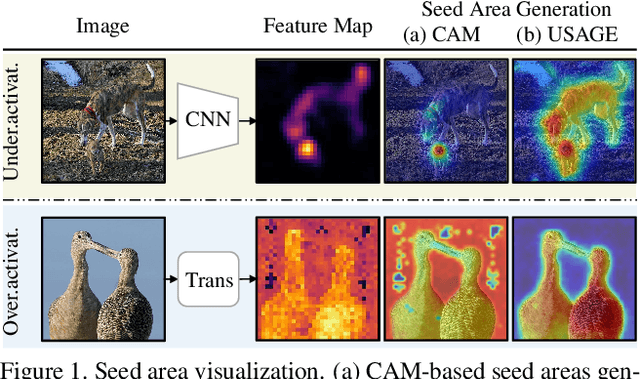
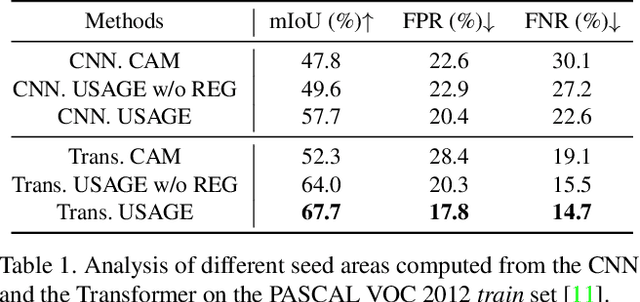
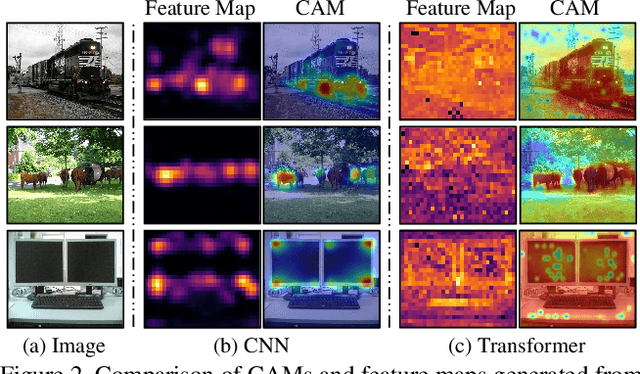
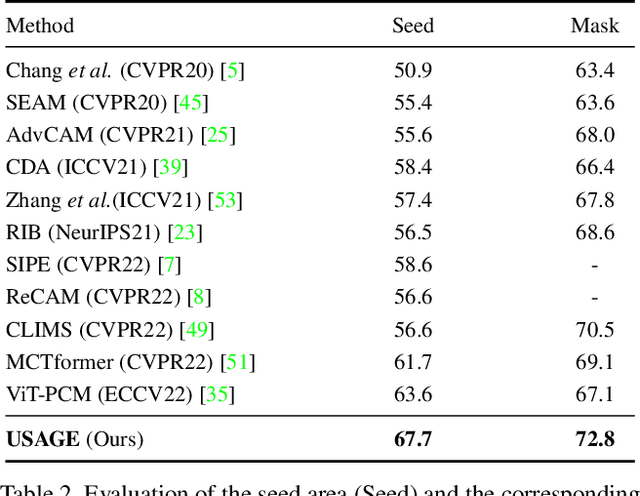
Abstract:Seed area generation is usually the starting point of weakly supervised semantic segmentation (WSSS). Computing the Class Activation Map (CAM) from a multi-label classification network is the de facto paradigm for seed area generation, but CAMs generated from Convolutional Neural Networks (CNNs) and Transformers are prone to be under- and over-activated, respectively, which makes the strategies to refine CAMs for CNNs usually inappropriate for Transformers, and vice versa. In this paper, we propose a Unified optimization paradigm for Seed Area GEneration (USAGE) for both types of networks, in which the objective function to be optimized consists of two terms: One is a generation loss, which controls the shape of seed areas by a temperature parameter following a deterministic principle for different types of networks; The other is a regularization loss, which ensures the consistency between the seed areas that are generated by self-adaptive network adjustment from different views, to overturn false activation in seed areas. Experimental results show that USAGE consistently improves seed area generation for both CNNs and Transformers by large margins, e.g., outperforming state-of-the-art methods by a mIoU of 4.1% on PASCAL VOC. Moreover, based on the USAGE-generated seed areas on Transformers, we achieve state-of-the-art WSSS results on both PASCAL VOC and MS COCO.
SdAE: Self-distillated Masked Autoencoder
Jul 31, 2022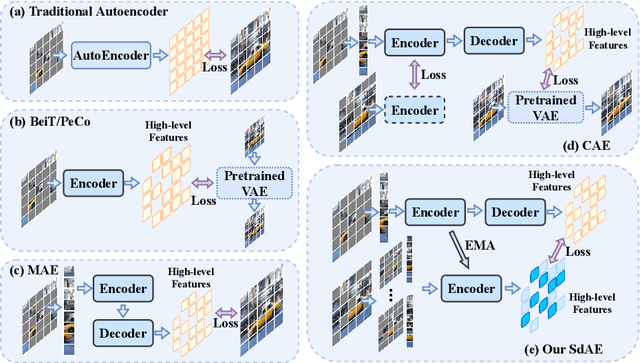



Abstract:With the development of generative-based self-supervised learning (SSL) approaches like BeiT and MAE, how to learn good representations by masking random patches of the input image and reconstructing the missing information has grown in concern. However, BeiT and PeCo need a "pre-pretraining" stage to produce discrete codebooks for masked patches representing. MAE does not require a pre-training codebook process, but setting pixels as reconstruction targets may introduce an optimization gap between pre-training and downstream tasks that good reconstruction quality may not always lead to the high descriptive capability for the model. Considering the above issues, in this paper, we propose a simple Self-distillated masked AutoEncoder network, namely SdAE. SdAE consists of a student branch using an encoder-decoder structure to reconstruct the missing information, and a teacher branch producing latent representation of masked tokens. We also analyze how to build good views for the teacher branch to produce latent representation from the perspective of information bottleneck. After that, we propose a multi-fold masking strategy to provide multiple masked views with balanced information for boosting the performance, which can also reduce the computational complexity. Our approach generalizes well: with only 300 epochs pre-training, a vanilla ViT-Base model achieves an 84.1% fine-tuning accuracy on ImageNet-1k classification, 48.6 mIOU on ADE20K segmentation, and 48.9 mAP on COCO detection, which surpasses other methods by a considerable margin. Code is available at https://github.com/AbrahamYabo/SdAE.
A Survey on Label-efficient Deep Segmentation: Bridging the Gap between Weak Supervision and Dense Prediction
Jul 04, 2022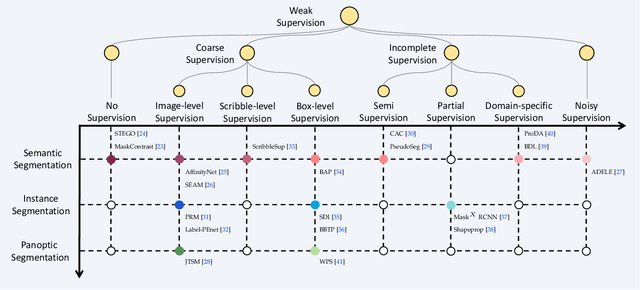
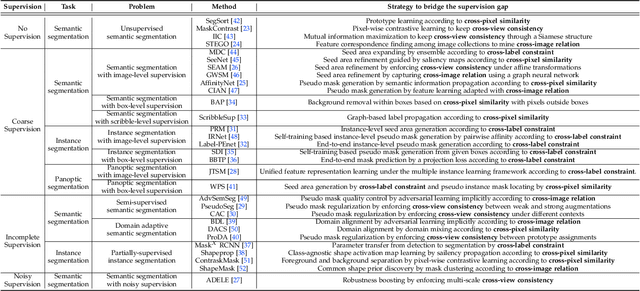
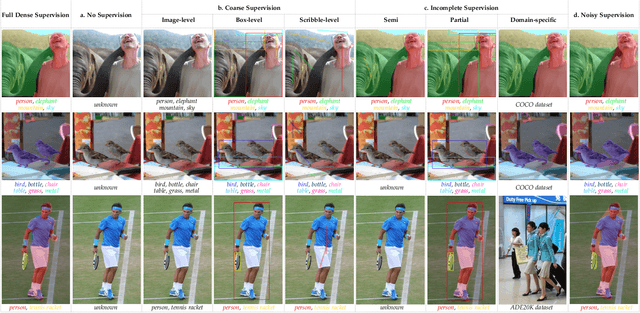
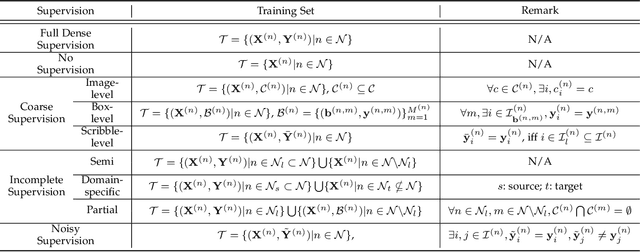
Abstract:The rapid development of deep learning has made a great progress in segmentation, one of the fundamental tasks of computer vision. However, the current segmentation algorithms mostly rely on the availability of pixel-level annotations, which are often expensive, tedious, and laborious. To alleviate this burden, the past years have witnessed an increasing attention in building label-efficient, deep-learning-based segmentation algorithms. This paper offers a comprehensive review on label-efficient segmentation methods. To this end, we first develop a taxonomy to organize these methods according to the supervision provided by different types of weak labels (including no supervision, coarse supervision, incomplete supervision and noisy supervision) and supplemented by the types of segmentation problems (including semantic segmentation, instance segmentation and panoptic segmentation). Next, we summarize the existing label-efficient segmentation methods from a unified perspective that discusses an important question: how to bridge the gap between weak supervision and dense prediction -- the current methods are mostly based on heuristic priors, such as cross-pixel similarity, cross-label constraint, cross-view consistency, cross-image relation, etc. Finally, we share our opinions about the future research directions for label-efficient deep segmentation.
Swin-Unet: Unet-like Pure Transformer for Medical Image Segmentation
May 12, 2021


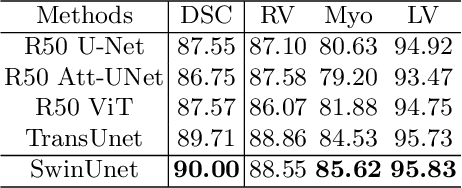
Abstract:In the past few years, convolutional neural networks (CNNs) have achieved milestones in medical image analysis. Especially, the deep neural networks based on U-shaped architecture and skip-connections have been widely applied in a variety of medical image tasks. However, although CNN has achieved excellent performance, it cannot learn global and long-range semantic information interaction well due to the locality of the convolution operation. In this paper, we propose Swin-Unet, which is an Unet-like pure Transformer for medical image segmentation. The tokenized image patches are fed into the Transformer-based U-shaped Encoder-Decoder architecture with skip-connections for local-global semantic feature learning. Specifically, we use hierarchical Swin Transformer with shifted windows as the encoder to extract context features. And a symmetric Swin Transformer-based decoder with patch expanding layer is designed to perform the up-sampling operation to restore the spatial resolution of the feature maps. Under the direct down-sampling and up-sampling of the inputs and outputs by 4x, experiments on multi-organ and cardiac segmentation tasks demonstrate that the pure Transformer-based U-shaped Encoder-Decoder network outperforms those methods with full-convolution or the combination of transformer and convolution. The codes and trained models will be publicly available at https://github.com/HuCaoFighting/Swin-Unet.
 Add to Chrome
Add to Chrome Add to Firefox
Add to Firefox Add to Edge
Add to Edge